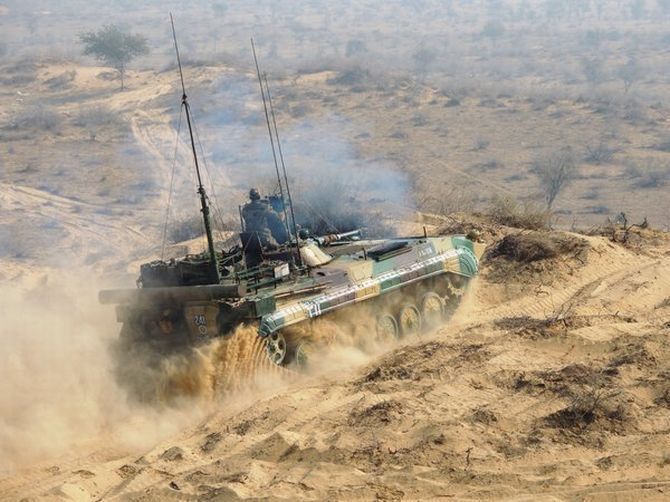'Should the two armies clash in a conventional battlefield, the advantage will pass more and more to the Indians as the battle progresses,' says Brigadier S K Chatterji (retd).

The Pakistani budget for the next financial year was presented on May 26. The Rs 4.75 trillion budget (all figures are in Pakistani rupees, except where specified), allocates Rs 920.2 billion for defence.
India has allotted $52 bn for its defence budget as compared to Pakistan’s $8.8 billion.
Pakistan ranks 23rd in terms of defence expenditure globally, and spends 2.3% of its GDP on defence.
India ranks 5th and spends 1.62% of its GDP on defence.
Home to the 6th largest population in the world, Pakistan's economy is ranks 25th globally.
India has the second largest population and is the 7th largest economic power.
If a closer look at the Pakistan armed forces is taken, the strength of its regulars is the 6th largest in the world with over 620,000 personnel.
The strength of its army is approximately 550,000. The Pakistan air force has 45,000 personnel while its navy has 22,000 officers and sailors.
In terms of threat perception, the major threat that Pakistan appreciates is from India.
Unlike India, where a two front threat has to be simultaneously catered for, Pakistan definitely has an advantage. It has only to cater for a single front.
However, that does not imply that it has no other threats to its stability.
Pakistan view its neighbour across the Durand Line -- Afghanistan -- most sceptically.
Posts along this border flare up occasionally, necessitating deployment of border guarding forces, and tasking a fair number of formations for that front.
Afghanistan, in its present state, is not a major threat and Pakistan understands that the Afghans will not be able to raise threat levels as long as they are unstable.
Pakistan ensures that stability eludes Afghanistan by backing anti-Kabul forces consistently.
The Pakistan-Iran border also hots up occasionally, though the periodicity of such outbreaks are few and far in between.
In addition to these threats, Pakistan has insurgencies and terrorist groups operating almost all across the country. These have often called for major deployment of military resources.
The China Pakistan Economic Corridor also requires protection. Pakistan has raised a special security division and a maritime security force of 15,000 men from the armed forces.
The former will safeguard the 34 CPEC projects scheduled to take off while the latter will provide security to the coastal areas.
The continued build-up of nuclear forces and weapon systems also calls for money.
Pakistan is looking for a triad capability -- the ability to launch its nuclear arsenal from land, sea and air.
The Pakistani armed forces have also been given a 10% increase in their pay and allowances, over and above their normal raises.
While a lot of its expenditure on defence may have been underwritten by the Chinese, the Americans and the Saudis in the past, it's time for a reality check in Pakistan.
The American contribution is drying up. Saudi Arabia may not be able to fund Pakistan as it did in the days when crude was selling at $100 a barrel.
The Chinese could also be more focussed on the China Pakistan Economic Corridor rather than defence!
The CPEC will bring in billions of dollars, but the Pakistanis will have to bear the costs of providing security to the corridor that runs, for its larger length, through areas prone to violence.
It might also lead to a debt trap, deterioration of social cohesion in Pakistan and consequently the security situation, leading to poorer business climate affecting projected GDP growth.
The Pakistani defence budget 2017 marks a 7% increase in allotment as compared to the previous year.
The average annual hike of the defence budget in the last six years has been around 11%, except for an increase of 15% in 2013-2014.
The allocations for the three services are not available, but going by trends the army should get around 50%, while the share of the air Force and navy could be around 30 and 20%, respectively.
The operating expenses (akin to the revenue budget) amounts to Rs 225.5 billion.
Pensions and salaries will consume Rs 322 billion.
An additional amount of Rs 180 billion has been set aside, beyond the defence budget, for the pensions of veterans.
An amount of Rs 244 billion has been allocated for physical assets and another Rs 128 billion earmarked for civil works.
The nuclear programme and operations in FATA are not included in the defence budget.
The state of equipment of the Pakistani armed forces is mixed with older vintage equipment being the case mostly.
The main battle tank is the Al Khalid, an early 1990s design with Chinese cooperation. The 48 ton tank uses an Ukraine manufactured 1200 horse power engine. It is not quite in the same class as the Indian main battle tank, the T-90.
Pakistan's artillery is composed of a variety of calibres and requires standardisation. Though Indian artillery has not undergone major upgrades in the last two decades, the acquisition of multi barrel rocket launchers to include Pinaka and Smerch, upgunning of 130 mm guns give India a definite edge.
In terms of numbers, the Indians lead by a huge margin in most systems.
The Pakistan air force definitely lags behind the Indians. In the case of its navy, they have no aircraft carriers. Nor are their surface vessels and submarine assets comparable to the Indian Navy.
The areas where Pakistan has an edge are in attack helicopters, air defence systems and electronic warfare systems.
Overall, it may be said that should the two armies clash in a conventional battlefield -- quite unlikely as such -- the advantage will pass more and more to the Indians as the battle progresses, with the Pakistanis losing ground gradually.
The Pakistani forces' strategic partners, the terrorist groups nurtured for decades, proved an abject failure during the Kargil war and have hardly any potential to make a dent in the Indian capabilities.
Pakistan will also not be able to keep in step with the Indian pace of modernisation with an economy that is far smaller than that of India.
The growth rates of the two countries are also set apart substantially. While the Pakistani economy is likely to grow at over 5%, the Indian growth rate should cross 7%.
Of course, the scenario of a two front attack on India by a collusion between the Chinese and the Pakistanis is a far graver situation for the Indians.
IMAGE: A tank on the move during the Shatrujeet exercise in the deserts of Rajasthan, April 2016. Photograph: @SpokespersonMoD










